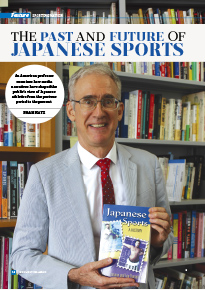Home > Highlighting JAPAN >Highlighting Japan October 2015>Sporting Nation
Highlighting JAPAN

Sporting Nation
The Past and Future of Japanese Sports
An American professor examines how media narratives have shaped the public’s view of Japanese athletics from the postwar period to the present.

Why do people watch sports? According to Lee Thompson, a professor at the Faculty of Sport Sciences of Waseda University in Tokyo, “We like sports because they tell a story, and these stories tell us about who we are.”
Thompson teaches classes on sports and their representation in the media since, as he puts it, “most of us . . . rely on the media to tell that story.” As a sociologist who established his career in Japan, the U.S. national has examined the influences of the media and modernization on Japanese sports.
While an exchange student in Japan, he worked for national broadcaster NHK as well as two cable television companies, which piqued Thompson’s interest in the media. Later, his research on the popularity of live TV broadcasts of sumo and professional wrestling in the 1950s inspired him to focus on the media’s role in depicting sports for his graduate studies at Osaka University.
Further research led Thompson to examine the modernization of sumo in response to changing times and media. He discovered that sumo matches in Japan’s Edo Era (1603–1868) were quite different from those today. “For example, they didn’t compare individual records over the course of a tournament and use that to determine a single overall winner—what you saw was what you got,” he explains. Thompson believes that modern newspapers introduced the championship as a way to generate interest and sell more copies.
Contrary to the appearance of traditions unchanged since the feudal era, Thompson also found that some key elements in sumo were introduced in the past century. By way of example, he elaborates on how the referee clothing resembling the garb of a Shinto priest was added in the early 1900s, while the roof that hangs over the ring was incorporated in the 1930s, modeled in the same architectural shinmei-zukuri style as Japan’s Ise Shrine.
Modernization and its close relative, internationalization, have been a mixed blessing to sports in Japan. Thompson observes ambivalence in the country about the global spread of traditional Japanese sports, for instance, as “people here want Japanese sports to be globally popular but also want to win.” Foreign athletes are dominating in sports such as judo and sumo that were once regarded as quintessentially Japanese. (No Japanese-born sumo wrestler has won a tournament championship in almost ten years, for example.)
Nevertheless, internationalization has also energized the Japanese sporting world. Japanese athletes have succeeded in Western sports such as baseball, golf and tennis, and gained tremendous popularity abroad as well as at home. “The impact of Japanese athletes in other sports has really changed the perception of them [in the world],” Thompson says, recalling images he has seen of children overseas who imitate the swinging stance of baseball great Ichiro Suzuki. “This is really where their influence is greatest.”
Although Thompson sees the overall popularity of Japanese martial arts slowing abroad due to increasing availability of martial arts from Korea, China and elsewhere, he has observed some success with the spread of sumo. He says the Japan Sumo Federation, which oversees amateur sumo competition, has been promoting sumo internationally with the goal of having it accepted as an Olympic sport.
The 2020 Tokyo Olympics is now the big story that both Thompson and the media alike are paying the closest attention to. “That event is gradually dominating any discussion of sport in Japan,” he says. “Its success will be discussed for years to come.” And for the fans, it’s yet another story only waiting to unfold.
© 2009 Cabinet Office, Government of Japan






